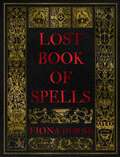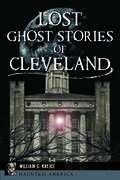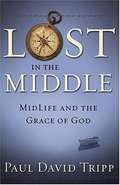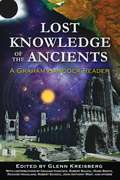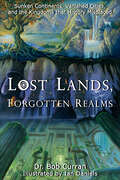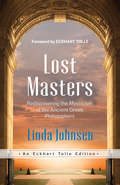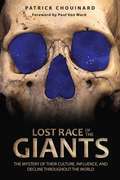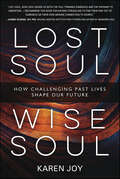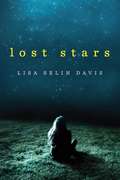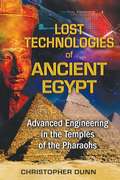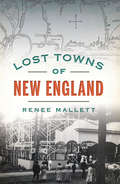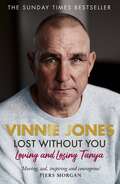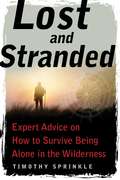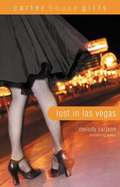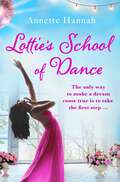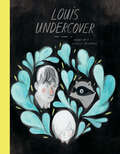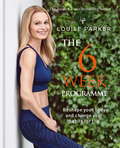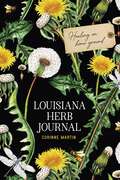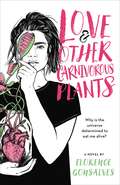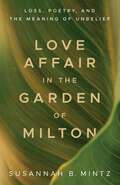- Table View
- List View
Losing Uncle Tim
by Marykate JordanWhen his beloved Uncle Tim dies of AIDS, Daniel struggles to find reassurance and understanding and finds that his favorite grown-up has left him a legacy of joy and courage.
Losing Weight with Your Diabetes Medication: How Byetta and Other Drugs Can Help You Lose More Weight than You Ever Thought Possible (Marlowe Diabetes Library)
by David MendosaAn essential and inspirational breakthrough for diabetes patients who want to take control over their condition, end the cycle of ineffective diets, and finally shed unwanted weight
Lost Book of Spells
by Fiona HorneDiscover a grimoire of over 150 spells from leading witch Fiona HorneLost for many years, this collection draws together over 30 years of spells old and new created by Fiona Horne for everything from traditional topics such as love and relationships, self-care and wellbeing, and money and work, to up-to-the-minute issues such as social media challenges, environmental concerns and mental health in our busy modern world. Fiona Horne guides you through how to spellcast as well as different kinds of natural magick such as working with the energy of the moon and sun, and shares the secret of crafting a magickal life: stop asking for things just for you and start helping others instead. A treasure trove of magickal advice and know-how, this spell book will show you how to charm away a cold or flu, how to make your in-laws to like you, spells to find new love or add spice to your relationship, magick yourself into a new job and much more. Whether you're an experienced practitioner or just starting on your magickal life, this book is for you.
Lost Ghost Stories of Cleveland (Haunted America)
by William G. KrejciRediscover Cleveland's Forgotten Hauntings Hiding in obscure corners and in plain sight, chilling tales from Cleveland's paranormal past await reawakening. A tale from 1840 places the city's first haunted house on the windswept commons south of town. Hanged murderers were said to roam the corridors of the Old County Jail, and t he 1885 disinterment of the old Cleveland Medical College graveyard led to reports of nocturnal phantoms throughout the excavation. With the construction of Bulkley Boulevard in 1912, many West Side homes were demolished. Also destroyed was the entrance to what neighbors menacingly called The Cave of Apparitions. Take a step back in time with author and investigative historian William G. Krejci on this journey through Cleveland's long lost ghostly past.
Lost In The Middle: Midlife and the Grace of God
by Paul David TrippThe Bible never discusses midlife, just like it never discusses teenagers. Yet the Bible is able to address any of life's experiences because it was written by the One who made them all. You will face things in midlife that beat at the borders of your faith, but you do not have to be lost in the middle of your story. You do not have to be paralyzed by regret, defeated by aging, and discouraged by the passing of your dreams. This middle period of life, which can seem like the end of many things, can actually welcome you to a brand new way of living. As is so often the case in your walk with the Lord, this moment of pain is also a moment of grace.
Lost Knowledge of the Ancients: A Graham Hancock Reader
by Glenn KreisbergThinkers at the forefront in alternative theories on history, the origins of civilization, technology, and consciousness • With contributions by Graham Hancock, Robert Bauval, Mark Booth, Richard Hoagland, Robert Schoch, John Anthony West, and others • Topics range from quantum philosophy and paranormal phenomena to the secret history of NASA, instant polar shifts, and ancient Martian civilizations • Explores where our present time fits into the cycle of human existence A revolution of thought is under way in our world, fostered by decades of research and well-documented evidence by alternative theory pioneers such as Graham Hancock, John Anthony West, Robert Bauval, and Robert Schoch. These provocative, cutting-edge scholars now represent a direct challenge to the academic establishment as the paradigms of science and history shift and their ideas gain acceptance. Representing the latest, often controversial findings in scientific and historical research, this anthology of essays commissioned by Graham Hancock, bestselling author of Fingerprints of the Gods, covers the forefront in alternative theories on history, the origins of civilization, technology, and consciousness with topics ranging from quantum philosophy and paranormal phenomena to the ancient use of electromagnetism, the effect of cosmic rays on human evolution, and NASA’s cover-up of ancient Martian civilizations. Recognizing that many recent discoveries are actually rediscoveries of lost knowledge from past civilizations, these authors seek to understand where, within the bigger picture of human knowledge, our present time fits into the cycle of human existence.
Lost Lands, Forgotten Realms: Sunken Continents, Vanished Cities, and the Kingdoms that History Misplaced
by Bob Curran“A comprehensive encyclopedia of fantastic places straddling the nebulous borderlands between fact and fantasy.” —Frank Joseph, author of Opening the Ark of the CovenantThere are places that turn up in literature or in film—mystical and legendary places whose names may be familiar but about which we know little. We nod knowingly at the reference, but are often left wondering about places such as Atlantis, the lost land overwhelmed by the sea, or El Dorado, the fabulous city that vanished somewhere in the South American jungles. Other names are more evocative—Mount Olympus, the Garden of Eden, the mystic Isle of Avalon, and Davy Jones’ Locker.But did such places actually exist and if so, where were they, and what really happened? What are the traditions and legends associated with them? In the fascinating book, Lost Lands, Forgotten Realms, historian Dr. Bob Curran sets out to find the answers by journeying to the far-flung corners of the world and to the outer reaches of human imagination.“In this fascinating encyclopedia of places that time forgot, Irish psychologist and historian Dr. Bob Curran brings the legends alive.” —Nexus magazine“Learned and erudite, yet written in an accessible and exceptionally readable style, this book is invaluable for those interested in the mysteries of vanished civilizations.” —Brian Haughton, author of Hidden History
Lost Masters: Rediscovering the Mysticism of the Ancient Greek Philosophers (An Eckhart Tolle Edition)
by Linda JohnsenAshrams in Europe twenty-five hundred years ago? Greek philosophers studying in India? Meditation classes in ancient Rome? It sounds unbelievable, but it’s historically true. Alexander the Great had an Indian guru. Pythagoras, Empedocles, and Plotinus all encouraged their students to meditate. Apollonius, the most famous Western sage of the first century c.e., visited both India and Egypt—and claimed that Egyptian wisdom was rooted in India. In Lost Masters, award-winning author Linda Johnsen, digging deep into classical sources, uncovers evidence of astonishing similarities between some of the ancient Western world’s greatest thinkers and India’s yogis, including a belief in karma and reincarnation. Today ancient Greek philosophers are remembered as the founders of Western science and civilization. We’ve forgotten that for over a thousand years they were revered as sages, masters of spiritual wisdom. Lost Masters is an exploration of our long-lost Western spiritual heritage and the surprising insights it can offer us today.
Lost Race of the Giants: The Mystery of Their Culture, Influence, and Decline throughout the World
by Patrick Chouinard Paul Von WardAn exploration of mythological and archaeological evidence for prehistoric giants • Examines the many corresponding giant mythologies throughout the world, such as the Greek and Roman titans, Norse frost giants, and the biblical Nephilim • Reveals recent finds of giant skeletons in the deserts of Saudi Arabia and India • Explains how giants passed on their sophisticated culture and civilization to humanity before being wiped out in the great age of cataclysms and floods Giants are a cornerstone of the myths, legends, and traditions of almost every culture on Earth. Stories of giants are often considered fantasies of the ancients or primitive attempts to explain natural phenomena, but archaeological discoveries of 10- and 12-foot skeletons--many of which have been suppressed--confirm the existence of a forgotten golden age of giants before recorded history. Patrick Chouinard examines the staggering number of corresponding giant mythologies throughout the world, such as the Greek and Roman titans, Norse frost giants, the Hindu Daityas, the biblical Nephilim, the Celtic Formorach, the Sumerian Anunnaki, and the multitude of myths in which the sky or world is held aloft on the shoulders of a giant. He links these stories to Atlantis as well as other legends of prehistoric civilizations lost to cataclysm and great floods whose survivors spawned the rise of ancient civilizations. The author reveals how physical remains of giant-size peoples have been found on almost every continent, including recent finds in the deserts of Saudi Arabia, Afghanistan, and northern India as well as hundreds of excavations of giant mummies and skeletons across the United States, corresponding directly with Native American accounts of red-haired giants. He also examines reports from famous explorers such as Magellan, Sir Francis Drake, and Desoto of their encounters with giants on the North American continent. Revealing how giants represent the true earthborn race, Chouinard explains how they engaged in open conflict with the extraterrestrial gods who created humanity for forced labor and how they passed their sophisticated culture and civilization on to humanity before being nearly wiped out in the great age of cataclysms.
Lost Soul, Wise Soul: How Challenging Past Lives Shape Our Future
by Karen JoyExplore Challenging Past Lives and How They Can Change Your FutureDrawing on her most compelling client cases, Karen Joy shows you the natural arc of a soul's journey over many lifetimes, including violent or negative ones. She reveals how our souls begin, how we enter lives on earth, and how facing a diverse range of experiences teaches us to be wiser and happier.Over many lifetimes, most souls have played the dual roles of victim and perpetrator. The trauma of these past lives—especially those that harmed others—can burden your soul, causing your present self to struggle with negative experiences. Learn how challenges can lead you astray, how energy can be carried from one incarnation to the next, and how your soul can move toward balance. Through inspiring case studies, Lost Soul, Wise Soul demonstrates how anyone can overcome a past life history of unethical or shameful behavior and live a life filled with peace, love, and joy.
Lost Stars (A Broken Code #1)
by Lisa Selin DavisEleanor & Park meets Perks of Being a Wallflower in this bittersweet 1980’s story about love, loss, and a comet that only comes around every ninety-seven years. When Carrie looks through her telescope, the world makes sense. It’s life here on Earth that’s hard to decipher. Since her older sister, Ginny, died, Carrie has been floating in the orbit of Ginny’s friends, the cool kids, who are far more interested in bands and partying than science. Carrie’s reckless behavior crosses a line, and her father enrolls her in a summer work camp at a local state park. There, Carrie pulls weeds and endures pep talks about the power of hard work. Despite her best efforts to hate the job, Carrie actually feels happy out in nature. And when she meets Dean—warm, thoughtful, and perceptive—she starts to discover that her life can be like her beloved night sky, with black holes of grief for Ginny and dazzling meteors of joy from first love.
Lost Technologies of Ancient Egypt: Advanced Engineering in the Temples of the Pharaohs
by Christopher DunnA unique study of the engineering and tools used to create Egyptian monuments • Presents a stone-by-stone analysis of key Egyptian monuments, including the statues of Ramses II and the tunnels of the Serapeum • Reveals that highly refined tools and mega-machines were used in ancient Egypt From the pyramids in the north to the temples in the south, ancient artisans left their marks all over Egypt, unique marks that reveal craftsmanship we would be hard pressed to duplicate today. Drawing together the results of more than 30 years of research and nine field study journeys to Egypt, Christopher Dunn presents a stunning stone-by-stone analysis of key Egyptian monuments, including the statue of Ramses II at Luxor and the fallen crowns that lay at its feet. His modern-day engineering expertise provides a unique view into the sophisticated technology used to create these famous monuments in prehistoric times. Using modern digital photography, computer-aided design software, and metrology instruments, Dunn exposes the extreme precision of these monuments and the type of advanced manufacturing expertise necessary to produce them. His computer analysis of the statues of Ramses II reveals that the left and right sides of the faces are precise mirror images of each other, and his examination of the mysterious underground tunnels of the Serapeum illuminates the finest examples of precision engineering on the planet. Providing never-before-seen evidence in the form of more than 280 photographs, Dunn’s research shows that while absent from the archaeological record, highly refined tools, techniques, and even mega-machines must have been used in ancient Egypt.
Lost Towns of New England (Lost)
by Renee MallettNew England is home to abandoned towns and forgotten main streets that once bustled with life and commerce. From villages sunk underwater to cities undone by the rise and fall of mill life, madness or just plain bad luck, these ghost towns offer a unique look into the rich history of the past. Get a glimpse into what early life was really like through historical accounts of abandoned villages. Discover the history behind the ruins of towns like Connecticut's religious community Gay City, the former New Hampshire resort town of Unity Springs and Massachusetts's famed Dogtown--before nature reclaims them entirely. Join local author Renee Mallett as she uncovers the heydays of some of New England's most fascinating lost towns.
Lost Without You: Loving and Losing Tanya
by Vinnie Jones'This is not a love story I ever wanted to tell, because I hoped it would just go on and on, and never end. I thought that we'd grow old together. I never wanted it to be a tale.But here I am, a middle-aged man sitting at the kitchen table as the California light fades, thinking about the coming night and how to get through it. Trying to explain to someone - to anyone - what it was like to live through something extraordinary: an amazing three decades that happened to me. Three decades that are now over.'In July 2019 Vinnie Jones tragically lost his wife and soulmate Tanya after her six-year battle with cancer. Tanya and Vinnie had shared 27 amazing years and raised a beautiful family together. Her passing was a devastating shock to everyone - and Vinnie found himself struggling to cope.In this extraordinarily intimate memoir, Vinnie tackles his grief honestly and with heart, sharing warm and colourful stories from the 25 years he spent married to Tanya, and unfiltered accounts of the reality of grief. From the darkest hours to the happiest moments, and everything in between, it is tender and heart-breaking, deeply honest but also full of humour and hope.Written to honour Tanya's life, Lost Without You is a beautiful and brave story of love and loss. Nothing will take away the pain of Tanya's death, but if in sharing his experiences Vinnie can inspire others in the depths of the unspeakable to find the help they need, then he will have succeeded in the keeping her kind, caring and selfless spirit alive.
Lost and Stranded: Expert Advice on How to Survive Being Alone in the Wilderness
by Timothy SprinkleFor anyone who spends time in the backcountry, understanding not only what sorts of dangers you can run into out there but also exactly what those risks can do to you is part of being a smart, well informed outdoor traveler. In Lost and Stranded, author Timothy Sprinkle breaks down the perils that can befall hikers, hunters, and other outdoor enthusiasts. There are animal encounters, weather events (lightning strikes), parasites (giardia), biting insects (bees/wasps), winter hazards (avalanches), natural disasters (forest fires), hypothermia, dehydration, disorientation, and much, much more to worry about. Although these risks are generally well known, what’s less understood by many adventurers is what exactly happens to you when, say, you become malnourished in the backcountry. What does it feel like? How does the condition progress? How long do you generally have before the body shuts down? What helps or hurts when you’re fighting for survival? Lost and Stranded will answer these questions and many more by taking an inside look at more than two dozen outdoor hazards. Each one will include a narrative section that dramatizes the experience of a certain situation based on real-world events. From there, information from expert sources—medical doctors, first responders, wildlife experts, and others—will fill in the details around exactly how each scenario plays out on the ground, followed by suggestions on how to avoid or survive each risk factor, making this book is a vital resource for outdoor travelers.
Lost in Las Vegas (Carter House Girls, Book #5)
by Melody CarlsonIt's Christmas break and DJ accepts "lonely" Taylor's invitation to come to Las Vegas, where her mom's performing. DJ soon discovers that Taylor just wants to party, plus she's invited Eliza! So DJ calls on Casey to help and things get wild before Taylor ends up in rehab.
Lottie's School of Dance
by Annette HannahLottie Daniels is dancing up the altar in Canada when she realises her whirlwind wedding is a big mistake. Chad isn't the right person for her at all! And, in that moment, Lottie goes from dancing bride to runaway bride.Much to her brother's relief, Lottie decides to return to Bramblewood in the UK. But life has more surprises in store for her. After rescuing both a donkey and a little old lady called Doris - all with the help of a handsome stranger! - Lottie suddenly becomes a big part of Doris's life. From broken dreams to second chances, Lottie finally has a chance to rebuild her life. When her friends suggest she takes part in a dance audition she refuses point blank but it soon becomes clear that destiny has other plans.You are guaranteed to fall head over heels with this sweet and charming romance.
Lottie's School of Dance
by Annette HannahLottie Daniels is dancing up the altar in Canada when she realises her whirlwind wedding is a big mistake. Chad isn't the right person for her at all! And, in that moment, Lottie goes from dancing bride to runaway bride.Much to her brother's relief, Lottie decides to return to Bramblewood in the UK. But life has more surprises in store for her. After rescuing both a donkey and a little old lady called Doris - all with the help of a handsome stranger! - Lottie suddenly becomes a big part of Doris's life. From broken dreams to second chances, Lottie finally has a chance to rebuild her life. When her friends suggest she takes part in a dance audition she refuses point blank but it soon becomes clear that destiny has other plans.You are guaranteed to fall head over heels with this sweet and charming romance.
Louis Undercover
by Fanny BrittA stunning graphic novel from the award-winning creators of Jane, the Fox and Me.In this powerful new graphic novel from Fanny Britt and Isabelle Arsenault, we meet Louis, a young boy who shuttles between his alcoholic dad and his worried mom, and who, with the help of his best friend, tries to summon up the courage to speak to his true love, Billie.Louis’s dad cries — Louis knows this because he spies on him. His dad misses the happy times when their family was together, just as Louis does. But as it is, he and his little brother, Truffle, have to travel back and forth between their dad’s country house and their mom’s city apartment, where she tries to hide her own tears.Thankfully, Louis has Truffle for company. Truffle loves James Brown lyrics, and when he isn’t singing, he’s asking endless questions. Louis also has his friend Boris, with whom he spots ghost cop cars and spies on the “silent queen,” the love of his life, Billie.When Louis and Truffle go to their dad’s for two weeks during the summer, their father seems to have stopped drinking. And when Truffle has a close call from a bee sting, their mother turns up and the reunited foursome spend several wonderful days in New York — until they reach the end of the road, again.A beautifully illustrated, true-to-life portrayal of just how complex family relationships can be, seen through the eyes of a wise, sensitive boy who manages to find his own way forward.Key Text Featuresspeech bubblesCorrelates to the Common Core State Standards in English Language Arts:CCSS.ELA-LITERACY.RL.5.3Compare and contrast two or more characters, settings, or events in a story or drama, drawing on specific details in the text (e.g., how characters interact).CCSS.ELA-LITERACY.RL.5.4Determine the meaning of words and phrases as they are used in a text, including figurative language such as metaphors and similes.
Louise Parker: The 6 Week Programme
by Louise Parker'Louise Parker's programmes have helped Oscar-nominated film stars, royals and other movers and shakers.' - Mail on Sunday'Louise Parker has worked her magic on actors, athletes, pop stars, politicians and princesses and believes absolutely anyone can have a sensational body.' - Glamour'Louise Parker is one of the very few weight-loss experts worth the title. A genius method, an unbelievable client list and years of experience.' - Good Housekeeping'Quite simply the most intelligent weight-loss programme out there.' - Independent'Louise is the only one out there I trust' - Emma ThompsonThis book is for anyone truly wanting to change the way they live, reclaim their health and in doing so discover a body that's lean, strong and sustained with ease. It's about being the best version of yourself, being confident and happy in your skin and absolutely loving the way you live. I'm about to guide you through the first six weeks of a lifestyle overhaul, where you make yourself a priority and where your new habits will set you free.' - Louise Parker, bestselling author of The Louise Parker Method and Lean for Life: The CookbookLouise Parker's 6-Week Programme is a guided, motivational programme for transforming your body and enjoying the results for life. Week by week, you'll follow each of the four pillars of Louise's Method: eat beautifully, live well, think successfully and work out intelligently. You'll experience a complete mind-body reset and focus on acquiring the habits key to long-term success.PRAISE FOR LOUISE PARKER: THE SIX WEEK PROGRAMME 'It sounds not only doable but delightful' - The Telegraph '[Louise Parker is] a modern wellness guru'- The Telegraph
Louise Parker: The 6 Week Programme
by Louise Parker'Louise Parker's programmes have helped Oscar-nominated film stars, royals and other movers and shakers.' - Mail on Sunday'Louise Parker has worked her magic on actors, athletes, pop stars, politicians and princesses and believes absolutely anyone can have a sensational body.' - Glamour'Louise Parker is one of the very few weight-loss experts worth the title. A genius method, an unbelievable client list and years of experience.' - Good Housekeeping'Quite simply the most intelligent weight-loss programme out there.' - Independent'Louise is the only one out there I trust' - Emma ThompsonThis book is for anyone truly wanting to change the way they live, reclaim their health and in doing so discover a body that's lean, strong and sustained with ease. It's about being the best version of yourself, being confident and happy in your skin and absolutely loving the way you live. I'm about to guide you through the first six weeks of a lifestyle overhaul, where you make yourself a priority and where your new habits will set you free.' - Louise Parker, bestselling author of The Louise Parker Method and Lean for Life: The CookbookLouise Parker's 6-Week Programme is a guided, motivational programme for transforming your body and enjoying the results for life. Week by week, you'll follow each of the four pillars of Louise's Method: eat beautifully, live well, think successfully and work out intelligently. You'll experience a complete mind-body reset and focus on acquiring the habits key to long-term success.
Louise: A Memoir
by Louise Krug"A massive brain trauma robbed fashionable young Louise of the shallow currency she'd banked on all her life, and the resulting struggle is a page-turner in which a person's very soul deepens before your eyes. Louise: Amended rewards a reader's time-a must read."-Mary KarrA beautiful young woman from Kansas is about to embark on the life of her dreams-California! Glossy journalism! French boyfriend!-only to suffer a brain bleed that collapses the right side of her body, leaving her with double vision, facial paralysis, and a dragging foot. An unflinching, wise, and darkly funny portrait of sudden disability and painstaking recovery, the memoir presents not only Louise's perspective, but also the reaction of her loved ones-we see, in fictional interludes, what it must have been like for Louise's boyfriend to bathe her, or for her mother to apply lipstick to her nearly immobile mouth. Challenging the notion that one person's tragedy is a single person's story, Louise: Amended depicts a dismantling-and rebirth-of an entire family.At age twenty-two, Louise Krug suffered a brain bleed and underwent an emergency craniotomy that disrupted her ability to walk, see, and move half her face. Now, six years later, Louise has astounded doctors and loved ones by recovering not only much of her vision and mobility, but a ferocious spirit and enviable grace. She currently lives with her husband Nick and daughter Olive in Lawrence, Kansas, where she's a PhD candidate and teacher.
Louisiana Herb Journal: Healing on Home Ground
by Corinne MartinIn a world of constant change and crisis, the relationship between humans and their environment has never been more vital. Louisiana Herb Journal invites readers into the world of medicinal herbs, introducing fifty herbs found in Louisiana, with details on identification, habitat, distribution, healing properties, and traditional uses, including instruction on popular preparation methods such as tinctures and teas. Interspersed with these practical details, herbalist Corinne Martin shares stories that foster a true connection between readers and the world around them, from tales of childhood cherry picking to harvest mishaps to folklife traditions passed down through the generations. Accessible to experienced and rookie herbalists alike, Louisiana Herb Journal offers a new way of looking at the natural world, getting to know one’s “home ground” through a lens of healing and participation.Family connections, an intimate knowledge of the surrounding lands and waters, strong community bonds, an irrepressible resilience, and a great capacity for celebrating life despite hardships are part and parcel of what it means to be from Louisiana. A celebration of the state and the cultures of those who live there, Louisiana Herb Journal reflects on the value of medicinal herbs in promoting personal healing and addressing current challenges to the state’s environmental and economic stability. Readers will gain a deeper recognition of the natural wealth Louisiana enjoys and the ways that our stewardship of wild plants can impact our personal health as well as the state’s ecological future.
Love & Other Carnivorous Plants
by Florence GonsalvesA darkly funny debut for fans of Becky Albertalli, Matthew Quick, and Ned Vizzini about a nineteen-year-old girl who's consumed by love, grief, and the many-tentacled beast of self-destructive behavior. <P><P>Freshman year at Harvard was the most anticlimactic year of Danny's life. She's failing pre-med and drifting apart from her best friend. <P>One by one, Danny is losing all the underpinnings of her identity. When she finds herself attracted to an older, edgy girl who she met in rehab for an eating disorder, she finally feels like she might be finding a new sense of self. <P>But when tragedy strikes, her self-destructive tendencies come back to haunt her as she struggles to discover who that self really is. <P>With a starkly memorable voice that's at turns hilarious and heartbreaking, Love and Other Carnivorous Plants brilliantly captures the painful turning point between an adolescence that's slipping away and the overwhelming uncertainty of the future.
Love Affair in the Garden of Milton: Loss, Poetry, and the Meaning of Unbelief
by Susannah B. MintzLove Affair in the Garden of Milton interweaves the private story of a marriage coming apart with readings of John Milton’s poetry and prose. Connected essays chart the chaos of loss and the discovery of how a writer can inhabit our emotional as well as our intellectual selves. Inflected by the principles of mindfulness, Susannah B. Mintz’s memoir explores how we reconstruct ourselves and find our way back to meaning in the aftermath of trauma.Formally inventive and engaging dynamic philosophical ideas, Love Affair in the Garden of Milton raises questions of forgiveness, desire, identity, grief, and the counterintuitive relevance of literary tradition. This lyric memoir offers readers a sense of partnership, with the author and Milton as companionable guides through the wilds of love and loss.


